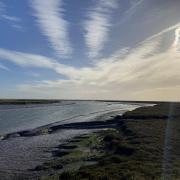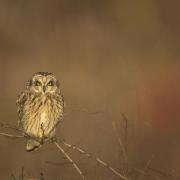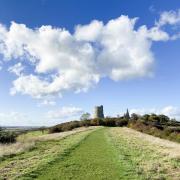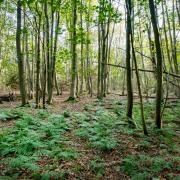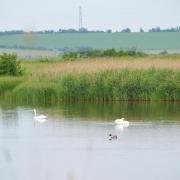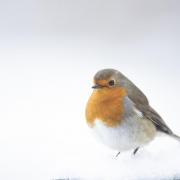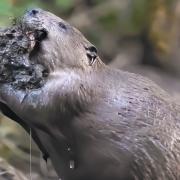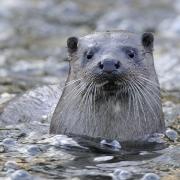A new collaborative project between Spains Hall Estate, the Environment Agency, Essex Wildlife Trust and the Essex and Suffolk Rivers Trust is helping to bring beavers back to the county of Essex after a 400 year absence

This spring saw a species return to Essex that had been absent from the county since the middle ages. The Eurasian beaver was once widespread throughout Britain, before they were hunted to extinction by the beginning of the 16th century for their meat, fur and scent glands.
Now a pair of beavers have been introduced into an enclosure in North Essex as part of a pioneering natural flood management scheme for East Anglia. Beavers are a 'keystone species', meaning they play an important role in the environment by creating ecosystems that provide habitats for many other plant, insect and mammal species. They are commonly referred to as 'ecosystem engineers' due to their ability to drastically modify and shape their surrounding environment.
The aim of this innovative project is to see if beavers will improve the biodiversity and help to reduce local flood risk as part of a new approach to flood prevention at the historic Spains Hall Estate, just upstream of the picturesque village of Finchingfield.
A second element of the project involves man-made natural flood management measures being introduced on Finchingfield Brook, which also flows through Spains Hall Estate. As well as helping to slow the flow after heavy rain, the scheme should also create wetland that will slowly release water in drier periods.
Spains Hall Estate owner, Archie Ruggles-Brise, explains: 'We have experienced first-hand the disruption caused by flooding in Finchingfield, so we are excited to be able to contribute to this novel approach to reducing flood risk, an undeniable public good.
'The added attraction of being able to pit nature against man to see who does it better will be a rare chance to learn and adapt our approach. We hope the project will also focus a spotlight on our little corner of rural North West Essex, a hidden gem normally only enjoyed by those in the know. We are keen to welcome more people to the area so they can see for themselves what they might be able to do back home.'

The partnership project is led by Spains Hall Estate, The Environment Agency, Essex Wildlife Trust and the Essex and Suffolk Rivers Trust, with funding from partners including the Anglian Eastern Regional Flood and Coastal Committee (RFCC). The whole story is being captured in a documentary series, due to be screened next year, overseen by renowned wildlife filmmaker Russell Savory.
The Environment Agency's Matt Butcher has high hopes for the project. 'Natural Flood Management can be a great way to reduce flood risk for communities where traditional flood defences are not appropriate,' says Matt.
'Introducing leaky dams along Finchingfield Brook should slow the flow and reduce flood peaks downstream while improving habitat in this fantastic landscape. The beavers bring another exciting dimension, as we can assess how effective they are at creating amazing new wetlands and as flood engineers.'
After the beavers were released into their secure, fenced enclosure with a small stream and 4 hectares of woodland, the animals got straight to work. In the first nine weeks they had already created nine dams, several large ponds and a lodge to live in.
But this is just the start of the process as they begin to dig canals across the flood plain to transport wood for food and building materials, and capture water from spring lines when the flow down the stream dried up. Spains Hall Estate has also been deluged with requests to visit and now offers tours as well as guided photography trips to see the beavers in action. More than 150 people have already journeyed to this stunning corner of North West Essex to see for themselves the difference the beavers are making.
Darren Tansley, River Catchment Coordinator for Essex Wildlife Trust, adds: 'Working with Government, other conservationists and a forward-thinking landowner to reduce flood risk in Finchingfield is an ideal opportunity for Essex Wildlife Trust. But the partners that eclipse us all are surely the beavers; natural engineers of our freshwater environment that we hope will trigger an explosion of biodiversity in their wake.'

In Devon, an almost identical sized project with Devon Wildlife Trust, which started in 2011, has yielded amazing results.
The beavers there are storing 1 million litres of water which seeps through their leaky dams to allow a constant flow of water off site, even during the most prolonged periods of drought when all the other streams have dried up. During heavy storms the peak flows are 30% less leaving the site than when they are flowing in, reducing the flood risk for downstream towns and villages.
Here we can see the basis for climate change reliance, allowing water to be harvested at times of deluge and released gradually during times of drought. It helps landowners and water companies plan their water abstraction more confidently and decreases the possibility of fish deaths. With ever more frequent and torrential storms in the summer months, beavers could now form a first line of defence for the village of Finchingfield.
Additionally, the Environment Agency has been monitoring the water coming off the beaver site and comparing it to that flowing along the neighbouring stream. Dissolved oxygen, so vital for aquatic insects and fish fry, is stable in the beaver stream but fluctuates each day at the man-made site, a fascinating result to see so early on in the project.
Essex & Suffolk Rivers Trust chairman Andrew Davies adds: 'This project brings river improvement through Natural Flood Management, betters the river environment for many other species and, by raising the profile of beavers, educates us all. It achieves many of our objectives as a Rivers Trust. It is a very exciting project for us to be involved with.'
This ten year-long experiment has only just begun to reveal its many secrets and successes. The impacts in the first few months have been remarkable and positive, but these amazing rodents still have much they can teach us about managing our water supplies.
Find out more
For more details of the project, as well as tours and photography trips, visit www.spainshallsestate.co.uk/nfm_beavers








